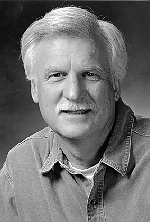How Clean is Clean?
Santa Cruz scientists find lower levels of trace metal contaminants than expected in well water. But whether the water is safer is anybody's guess.
Illustration by Lydia Neilsen
The Clean Room in Russell Flegal's laboratory is a plastic manufacturer's vision of heaven: plastic containers, plastic tubing, plastic gloves, plastic hood, plastic walls. Dust and dirt don't have a chance to sneak in. Positive air pressure keeps out airborne dust, and a sticky mat just inside the door traps any particles that you might have tracked in on your plastic booties.
elcome to the high-tech world of water-quality measurement. In labs like this one, scientists routinely tease out the one molecule per million in a water sample that can make the difference between a safe drink and a contaminated one. In the words of one researcher, "parts per million can kill." But this molecular sleuthing is tricky work. A stray speck of dust in the wrong place can impersonate a killer, and incriminate a stream or well that isn't a threat to human health.
Flegal, a professor of geosciences at the University of California at Santa Cruz, and graduate student Carol Creasey believe commercial environmental consultants have been sounding a lot of false alarms along with the real ones. At two wells in central California, they found that concentrations of seven metals - lead, cadmium, chromium, copper, nickel, silver and zinc - were from 2 to 1000 times lower than reported by a consulting company that used EPA-mandated procedures. The higher levels that the consultants saw, according to Creasey and Flegal, came either from contamination in their own labs or from pumping the water out of the wells too rapidly.

Russ Flegal says that measuring contaminants without using trace-metal clean techniques is like "weighing yourself with rocks in your pockets and saying that you weigh 10,000 pounds."
(Photo courtesy of UCSC Public Information Office.)